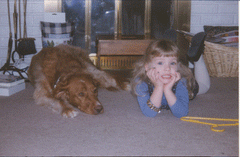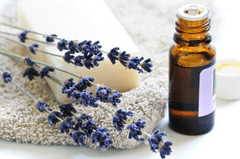Does your dog have thunder fear? Would you like to learn about natural ways to calm your pet?
Abby, our elder dog, looks a lot like me. Her nose is just a little longer and her red hair is natural, plus she has a bit more of it. Hers is naturally turning grey along her nose - not a problem I've had yet. She's a mixture of golden retriever for sure, the rest we're not sure about. She may even be all golden retriever and certainly has the temperament golden retrievers are known for. She has always been a very loving, sweet, gentle pet and has grown old while our family has been blessed with the addition of four grandchildren - each of which liked to pull on her ears and possibly a couple wanted to ride her. Each of them seemed fascinated by Abby and she loved the attention. In all the years, possibly 13, that we've had her, we've never seen her bare her teeth or snarl - ever (except once when my brother-in-law brought over his male dog who she didn't like much.) We've now added another dog, Brit, a beautiful and robust (understatement) Brittany Spaniel. Brit and Abby get along very, very well. I actually saw him let her take a raw bone from him just the other day. He seems to understand that she's the elder and he gives her her due respect.
Abby was a gift from a friend whose husband no longer wanted her because she wasn't a very good hunting dog. In fact, she was a terrible hunting dog because she had and has thunder fear. She doesn't have a mild case of it; no, she becomes absolutely crazy when she hears thunder, gunshots or fireworks. Over the years she has jumped our 4 foot fence more than once or twice. She doesn't know nor care where she's going, she just runs. We've learned that she can't be outside even at the hint of a storm and her favorite place during a storm was in our downstairs bathroom with the door closed thank you very much. I've tried many different things over the years to try to calm her. Melatonin was suggested but that didn't seem to help and it was difficult to get her to even take the pill. Petting and hugging, which normally is something she craves, didn't work at all. The vet once gave us a prescription for Valium, but I never filled it. We always know when a thunder storm is coming a good 20 to 30 minutes before it arrives because Abby starts her prancing around and getting anxious long before we hear the thunder.
This picture was when Abby was much younger - our granddaughter in this picture is now 15. The 2nd picture is of Abby and Brit about six months ago. Brit is somewhat bigger now.


Aromatherapy: As per our usual routine, I brought the dogs in one evening and frankly they didn't smell very good. So I grabbed my bottle of lavender and chamomile spray that I keep downstairs near the grandkids' bedroom. I've been known to spray under their beds and around their beds at night to help them sleep and calm them down. They love it and it seems to work quite well. I wasn't even thinking about the calming properties, I just wanted to neutralize some of the dog smell! I sprayed each dog and around the area they sleep in. I went back upstairs to finish doing whatever it was I was doing.
It was about an hour later that I heard the thunder. I immediately ran downstairs to put Abby into the bathroom before she got too upset. Instead, I found her asleep. Asleep! Considering her age, I quickly checked to see if she was breathing. She raised her head, gave me a calm, happy look and I think even lovingly licked my hand, and put her head back down. Very unusual I'm thinking. I waited a little bit to watch her and as the storm increased in intensity with lots of loud thunder, strong winds and lightening, Abby got up a few times and changed position, but went back to sleep!
Now I'm kicking myself wondering why in the world I hadn't thought of lavender and chamomile essential oils sooner!! I'm an aromatherapist! Idiot! The blend that I've used for years with myself and others for calming and relaxing purposes. It's a simple blend of True Lavender and Roman Chamomile and both as essential oils or herbs have a long history of being used for this purpose. I guess I can attest to the fact it works on dogs - or at least our dog.
Herbs: Since that time, I've had the opportunity to read and learn more about thunder fear. I've discovered it isn't an unusual problem and is, in fact, common with dogs. I've also learned that there are herbs that can be used successfully, although I haven't personally tried any of these remedies for Abby. I personally have used all of them at one time or another for myself or family members.
- Oats (Avena sativa) - According to Dr. Kidd's Guide to Herbal Dog Care: "A pet with upset nerves can benefit from a daily or few-times-a-week dose of oats. Cooked oatmeal added to your dog's food will help the nerves as well as provide a source of fiber."(1)
- St. John's Wort (Hypericum perforatum) - this herb is well-known for helping with depression for your pet as well as anxiety, tension or separation anxiety.
- Valerian (Valeriana officinalis) - it doesn't smell very good and I'm not sure how you'd get your pet to take it, but this herb is well-known for reducing tension and anxiety. It is recommended often as a sleep aid. There is a rumor that it was a favorite among Londoners during World War II and the seemingly endless bombing they experienced. Have you watched Foyle's War? Loved it.
- Chamomile (Anthemis nobilis and Matricaria recutita) - which is Roman Chamomile and German Chamomile respectively. I used the Roman Chamomile in the essential oil blend spray mentioned above. The herbs themselves are available in tea form and I buy them in bulk to make my own teas and infusions. They are both known as "potent sedatives used to reduce anxiety in a stressed animal". (1) These herbs may also ease an upset stomach and allow your pet to sleep during a car ride. Brit gets nauseous with just a short trip to the vet, so I'll have to try this on him.
- Kava Kava (Piper methysticum) - known to reduce anxiety and tension (including muscle tension) and calm restlessness. Kava Kava is often recommended to also relieve depression and generally create a sense of well-being, clear thinking and relaxed muscles. It is also often used in herbal sleep blends that appear to work and without being addictive or have residual effects in the morning. I read in one report that it could help with sociability - in people, not sure about dogs, but might be worth trying before taking your dog to the local dog run. However, this herb has come under some disrepute due to possible hepatic toxicity related to some kava herbal supplements containing pipermethystine from aerial stem peelings.Know your source and buy organic if possible.
- Lavender (Lavandula angustifolia) - which as a herb is also very relaxing and sedating and can be used to quiet a dog that barks a lot. Make a tea of the lavender and slightly moisten your pet's food. As an essential oil, it can be diluted in a carrier (vegetable) oil at 2 drops of oil to 1 tablespoon of oil - olive oil works nicely. Dab a little around your dog's ears and paws. I like the spray better, but there are many ways you can use essential oils. We use an ultrasonic diffuser in our room every night as I am a chronic insomniac. Why not try using it around where the dog's sleep or stay during a storm or anxious period?
- Catnip - well known for its ability to calm animals and people. It's one of my favorite ingredients in my evening tea and it grows like a weed in our yard. I love to dry it and store it for future use. I think I'll try putting some in Abby's food - except she doesn't eat when she's anxious and I'm assuming most dogs don't. I often mix catnip with lemon balm - both the herbs and the essential oils for their relaxing and calming properties.
Just like people, not all dogs will respond the same and what works for one might not work for another. These herbs can be blended together or used individually. Let me know if you try it, if it works or doesn't work. Try the essential oils too but remember they are the concentrated oils from plants and must be diluted prior to use. Always test a small amount of oil on your pet before using. Essential oils should NOT be used with cats. I used about 2.5 grams of essential oil per 8 oz of distilled water to make the spray. But you probably won't weigh everything like I do for all the products I make. Depending on the weight of the liquid, which changes slightly and especially with some essential oils, generally speaking 1 gram is equal to 1 milliliter (ml) and there are 2.5 mls per one-half of a teaspoon. If you are using a good dropper cap, this would be about 50 drops. Check out our dilution chart on essential oil use - coming soon.
Addendum added June 9, 2010. It occurred to me that not everyone wants to make this blend themselves and we do carry this blend of essential oils, True Lavender and Roman Chamomile, in our Lavender & Chamomile women's natural fragrance line. I used the body mist on the dogs that night and will in the future.

Thanks for listening!
Ann
1. Kidd, R. (2000). Herbal Dog Care. North Adams, MA: Storey Publishing.












Comments